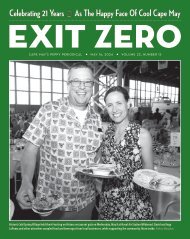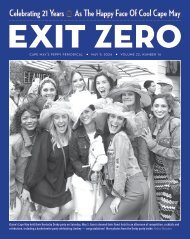V18 N30
V18 N30 October 22, 2020
V18 N30
October 22, 2020
Create successful ePaper yourself
Turn your PDF publications into a flip-book with our unique Google optimized e-Paper software.
Cape May Wicker<br />
Two locations open seven days 9 to 5<br />
1930 Route 9, Clermont | 609-624-3031<br />
203 Sunset Boulevard, West Cape May | 609- 884-1849<br />
Fall is Fire Table Season at Cape May Wicker!<br />
Now is the time to set out your feeders<br />
to attract wintering species.<br />
The large number of Pine Siskins<br />
moving through suggests this will<br />
be a winter marked by large numbers<br />
of winter finch like siskins and Purple<br />
Finches. Evening Grosbeak? You should be<br />
so lucky, but not impossible. Platform feeders<br />
or large hopper feeders loaded with black-oil<br />
sunflower seeds is the secret to attracting<br />
this portly bulbous-billed finch. However, you<br />
may not want swarms of grosbeaks at your<br />
feeder. The “grospig” as it’s called in some<br />
quarters can bankrupt your seed budget.<br />
Pine Siskin’s can also break the bank.<br />
Siskins and their close cousin the American<br />
Gold Finch love thistle which is priced like a<br />
prime cut of steak. You dispense it in special<br />
tube feeders with small ports or mesh thistle<br />
socks which the neighborhood gray squirrel<br />
will chew to pieces, leaving your thistle seed<br />
in a puddle on the ground. Many sparrow<br />
species like the mixed-seed blends, especially<br />
with millet. Avoid blends with corn as an<br />
Bird Droppings<br />
Dispatches from the nation’s birdwatching capital… by Seymore Thanu<br />
ingredient. This inexpensive “filler seed” is<br />
shunned by most songbirds and will end up<br />
under the feeder, attracting rats or mice.<br />
Another food offering to put out is suet.<br />
These blocks of kidney fat are relished by<br />
woodpeckers, nuthatches, jays, Carolina<br />
Wrens and unfortunately, racoons. Bringing<br />
your suet in at dusk will save you the trouble<br />
of searching for it. As for that hummingbird<br />
feeder, keep it up until a hard freeze. We still<br />
have several species of western hummingbirds<br />
that visit our feeder in late autumn.<br />
What a treat to find a feisty Rufous or Allen’s<br />
Hummingbird at your feeder. I hope you like<br />
company — when word gets out, birders will<br />
flock to your yard to see it.<br />
Watching birds at feeders is a great way to<br />
pass the time in this age of COVID isolation.<br />
Place feeders away from windows or glass<br />
doors but can still see them. If a bird-catching<br />
hawk makes birds scatter, you don’t want to<br />
have fleeing birds hitting your windows. Half<br />
of all window strikes end in fatality.<br />
Think of a hawk as another bird coming<br />
to your feeder. By feeding birds, you are not<br />
causing them to be killed. Hawks will feed<br />
twice a day. Your feeding birds means the<br />
hawk will catch dinner where you will see it.<br />
Wild Kingdom, right in your own back yard.<br />
For questions about bird feeding, the<br />
folks at Cape May Bird Observatory have<br />
answers. As for seed, Smeltzer and Sons in<br />
Court House has a fine selection of quality<br />
seed and suet blocks.<br />
capemaywicker.net<br />
Page 52 EXIT ZERO October 22, 2020 October 22, 2020 EXIT ZERO Page 53


















